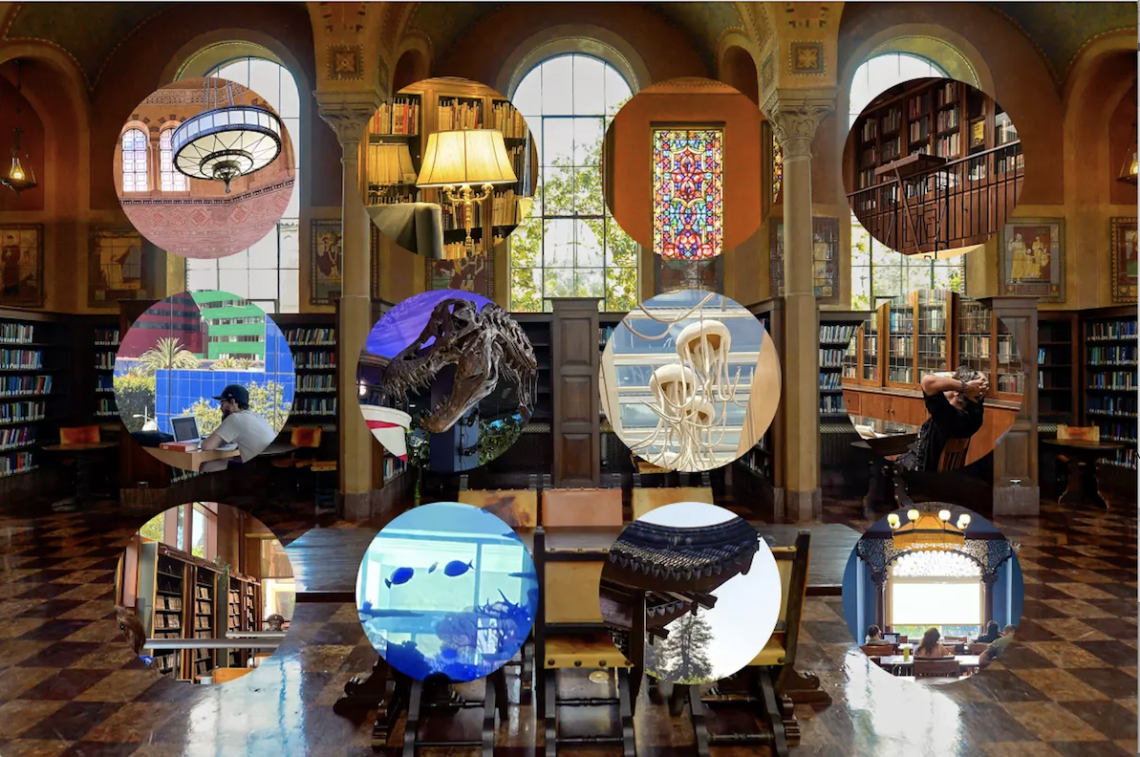
Assignment X: Reimagining Library Space (with Heart)
Cover photo: (Los Angeles Times photo illustration; Photos by Deborah Netburn/Los Angeles Times, USC)
I’ve been thinking about space. Not just the physical layout of a library, but something closer to the heart. What is space in the library and how do we define it? More importantly, who gets to define it?
In his essay “Age of Participation” Michael Stephens (2016) recounts a story about a museum in India that invited community members to curate exhibits made out of their own personal items. Imagine learning about your neighbor through the artifacts of their identity; imagine knowing your neighbor as art. This is creating human-centered services: a model that not only invites participation but insists upon it. The community becomes not just a participant, but a creator.
Library spaces, too, must be reimagined through this participatory lens. When we talk about space in a library, we tend to think in terms of rooms and their assigned functions. We call them by these functions – the children’s room, the computer lab, the makerspace, the teen zone. Space refers to a physical room, but also the expectations, behaviors, and prohibitions of that space. In “The Transparent Library”, Casey and Stephens (2008) ask library administrators to focus on “user-driven policy not driving users away”. Users are the heart of each space, and it’s crucial to see the space for all the ways in which they might gravitate towards using it, not the ways in which they must be managed.
Take the YA section, for example. On one hand, it is a space filled with tables, chairs, platforms, cushions, televisions, computers, video games, and graphic novels. But these items alone don’t make it a YA-friendly space. The space is defined by how young adults interact with it. It is simultaneously a space where young adults come to gather with friends, play the latest game, work on a school project, watch a movie, study, and craft. Careful consideration must be made to spaces beyond just their physical objects. If institutional policies restrict these behaviors, if teens are scolded for sharing chairs, speaking in groups, making noise, the space no longer serves its purpose. It’s not theirs. They merely occupy it and are told they occupy it wrong. It becomes performative.
I recently took Dr. Anthony Bernier’s INFO261-A Programming and Services for Young Adults, in which he discusses his concept of “fugitive postures”. These are informal ways that young adults occupy space, frequently adopting postures and seating that do not conform to traditional notions of how space should be used. They lay on the floor, they sit in each other’s laps, they drape their legs over the sides of chairs. Like the personal exhibit curators in India, these YAs become not just participants in services, but creators of their space.
Let’s say it louder for those in the back – the user must participate in creating their space! When people feel like they have a say in how their space is designed, arranged, used, and regulated, they are more likely to take ownership in it and thrive.
Michael Stephens beautifully captures this idea in Wholehearted Librarianship (2019), where he describes library spaces as “zones with heart”. These zones are built on community, creativity, curiosity, collaboration, with the final and most expansive zone being care itself. This is a holistic, whole-hearted framing that reminds us that libraries (especially the hyperlinked library!) are not just their collections or their technology, but people too. Libraries are their own ecosystems that grow along with their communities.
Truly responsive library systems and environments must embrace user engagement and participation in creating spaces. Users become partners, users become present, and space provides the threads for connection and creativity.
References
Bernier, A., & Males, M. (2014). YA spaces and the end of postural tyranny. Public Libraries, 53(4), 30–33. https://www.ala.org/sites/default/files/pla/content/publications/publiclibraries/pastissues/PL_53n4_JulyAug14.pdf
Casey, M. E., & Stephens, M. (2008, February 15). The transparent library: Six signposts on the way. Library Journal. https://www.libraryjournal.com/story/careers/the-transparent-library-six-signposts-on-the-way
Stephens, M. (2016). The age of participation. In The heart of librarianship: Attentive, positive, and purposeful change (pp. 79-81). ALA
Stephens, M. (2019). Zones with heart. In Wholehearted librarianship: Finding hope, inspiration, and balance (pp. 19-21). ALA Editions.

One Comment
Jane M
Hi Chandler,
Your focus on library space and how it has been and can be utilized really struck a chord with me, as I work as a librarian at an all-girls high school. You make a very important point that “items alone” do not make a space instantly attractive to young adults. Without meaningful use in an enriching atmosphere, these items are just stuff. I wasn’t familiar with “fugitive postures” as a concept, but it is certainly a reality in the library. Teenage life is stressful enough, it is important to provide them with a space that they can take refuge in to study, socialize, or just relax. Chances are, when you give them some say in choosing how the space operates and the resources they have access to, they will respect it because they are accountable for it.